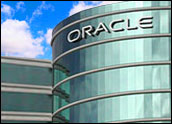
It’s very rare that you get clean demarcations between historical eras. Maybe the asteroid hitting the earth 65 million years ago was such an event, but I wasn’t there to experience it so I can’t tell you. Monday, Sept. 12, 2005 will go down as a deep line in the sand identifying the before and after in the enterprise software industry. It was the day that Siebel agreed to be acquired by Oracle, and coincidently, the day that Salesforce.com opened up its Dreamforce user conference in San Francisco.
The two events were like bookends, and this is as much about Oracle as it is about the rivalry between Salesforce.com and Siebel, because in one day, Oracle conceded any pretense of being a leading software industry innovator while Salesforce.com happily crowned itself. In all cases, the driving factor was not so much technology as it was business model and finance. Let me explain.
Building the Model
Oracle has been dominant in application development for a long time. Since the 1980s, first its database and later its tools and its enterprise business applications set the standards for how computing is done for big companies. Oracle ultimately spawned numerous software companies — Siebel and Salesforce.com among them — that essentially followed the same model of building large suites of software that enterprises would spend millions to license and millions more to configure, customize, install and train end users to operate.
Then the model started getting old. It was challenged by Salesforce.com more than five years ago and the upstart company with the brash slogan of “The end of software” got away with its challenge, turning itself into one of the fastest growing software companies — and a public company — in only six years. Meanwhile, Oracle, Siebel and all the others were content to play the part of lumbering dinosaurs.
Monday changed all that: On that day, Salesforce.com presented to the market its second major disruptive innovation in enterprise software when it announced Appforce and ApplicationExchange, two products that would definitively put an end to the tedious and expensive way we have come to believe enterprise software can and should be built.
Briefly, Salesforce announced that its users and partners could now use the Salesforce.com architecture to their hearts’ content to build any applications they want. More importantly, Salesforce.com, through its ApplicationExchange, lets all of these people evaluate, rate and purchase applications made by others for their own use within the hosted service. All applications built this way have the same underlying database, operating environment, look, feel, and security. And they can be manipulated and customized using the tools used to build them.
Globalization
For the first time in history application software development does not require a heavy investment in infrastructure. All that’s needed is a PC with an Internet connection and a browser. With such a low barrier to entry we can reasonably expect to see a swarm of new applications hit the market developed by people on the other side of the planet in economies with very different — read lower — measures of fair value for work. But it also means that if you have a garage or a spare room and a PC you can be in business too.
It is equally important to observe that with an online marketplace for enterprise software — which is effectively what the ApplicationExchange is — the cost of selling and marketing software will also come down significantly. “Frictionless” sales and marketing are words that come to mind here. Fewer people will be required to do the work so emerging software companies will not require the same amounts of money they once did, and that will have a profound effect on the venture capital community.
While we’re at it, the systems integration community is in for a shock of its own. Salesforce.com demonstrated how applications developed independently using its platform technology could integrate — automatically — with whatever else a customer is using from the vendor. Translation: you can take a test drive of new software with your own data at your leisure; there will be no more elaborate demos and proofs of concept.
The New Software Economy
In short, Salesforce.com introduced the world to a whole new software economy on Monday, the same day Oracle gave up on innovation and a week after Microsoft more or less did the same. Talk about inflection points. At Dreamforce, Salesforce.com CEO, Marc Benioff, compared Oracle to Computer Associates (CA), the company that bought up a number of mainframe software companies at the end of the mainframe era. CA’s strategy was to simply milk the maintenance stream until customers upgraded to client-server systems. Now, Oracle, the company that led the charge into the relational database era and client server computing, finds itself in a similar position.
You might ask why companies like Oracle and Microsoft, which are full of smart people, would take such predictably suicidal turns. And while the answers are numerous and complex, I think you need to look closely at business models and the financial community. Companies are founded on certain assumptions about how they make money (business model) and how much they can make (margin). The traditional client-server model, which is dying, has a built-in expectation of revenues and margins and so does the on-demand model. Unfortunately, the financial community simply wants to know how well your model worked in the 90-day period just ended.
In that way, the decline of a business model is like boiling a frog. But each successive model in this industry has offered orders-of-magnitude lower costs to the buyer — and lower margins for the vendor. Ultimately, I think it’s far easier for a company to burrow in and milk an installed base than it is to change its model and re-educate the public markets about the realities of doing business in a new era.
So rather than smooth transitions from one era or style of computing to another, we have seismic events like we saw on Monday. Don’t look for everything to change literally overnight; these things can take years — client-server took a decade.
There’s still work to be done building out the model, Salesforce.com is not the only player, and it may not ultimately be the one that gets all the way to the goal line. On the other hand, a decade might be far too long. I started writing about this new model two years ago in a white paper called “The New Garage” and I was very surprised at how quickly yesterday arrived.
Denis Pombriant is a well known thought leader in CRM and the founder and managing principal of the Beagle Research Group, a CRM market research firm and consultancy. Pombriant’s latest white paper, Adding Sales to the Call Center Agenda, summarizes his recent research in the call center industry. In 2003, CRM Magazine named Pombriant one of the most influential executives in the CRM industry. Pombriant is currently working on a book to be published next year. He can be reached at [email protected]






















































